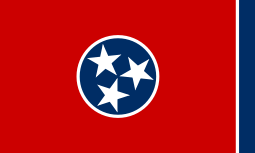University of Tennessee at Martin
 | |
| Motto | "Discover UT Martin" |
|---|---|
| Type | Public |
| Established | 1927[1] |
| Endowment | $27.2 million[2] |
| Chancellor | Robert Smith (interim)[3] |
Administrative staff | 835 |
| Students | 7,421 (fall 2013) |
| Undergraduates | 7,025 (fall 2013)[4] |
| Postgraduates | 396 (fall 2013) |
| Location | Martin, Tennessee, U.S. |
| Campus | Rural, 250 acres (100 ha) |
| Colors |
Blue and Orange[5] |
| Athletics | NCAA Division I FCS – Ohio Valley Conference |
| Nickname | Skyhawks |
| Affiliations | UT System |
| Website |
www |
 | |
The University of Tennessee at Martin (UT Martin, or UTM), located in Martin, Tennessee, in the United States, is one of the five campuses of the University of Tennessee system. Prior to the acquisition of Lambuth University in Jackson by University of Memphis in 2011, UTM was the only public four-year university in West Tennessee outside of Memphis. Although regionally accredited by the Southern Association of Colleges and Schools, the university was placed on probation in December 2015 for "falling short of standards related to evidence of institutional effectiveness and general education competencies."[6]
UTM operates a large experimental farm and several satellite centers in West Tennessee.
History
Although UT Martin dates from 1927, it is not the first educational institution to use the current site. In 1900, Ada Gardner Brooks donated a site on what was then the outskirts of Martin to the Tennessee Baptist Convention for the purposes of opening a school. The school opened as the Hall-Moody Institute, named for two locally prominent Baptist ministers. It originally offered 13 years of study, from elementary grades to the equivalent of the first years of collegiate work. The institute changed its name to Hall-Moody Normal School in 1917, as teacher training became its primary focus. Five years later, Hall-Moody changed its name again to Hall-Moody Junior College. Due to declining enrollment and financial difficulties in the mid-1920s, Hall-Moody Junior College was in danger of closing. In 1927, the Tennessee Baptist Convention made the decision to consolidate Hall-Moody with a similar institution, Union University, in nearby Jackson.[7]
Upon hearing of the impending closure of the Hall-Moody campus, area civic and political leaders asked the state of Tennessee to step in and take over the former Hall-Moody facilities under the auspices of the University of Tennessee. University of Tennessee president Harcourt Morgan agreed to accept the proposition on the condition that the Martin community would acquire the property as well as space for expansion. The City of Martin and Weakley County sold bonds to purchase the campus and some surrounding land. On February 10, 1927, Senate Bill Number 301 established the University of Tennessee Junior College in Martin. On March 29, it was officially approved by Governor Austin Peay. Hall-Moody closed for the last time on June 1, and the new UT Junior College began operations on September 2 with 120 students[1]
The school nearly closed twice during its first quarter-century, first during the hard times of the Great Depression and again when nearly all male students enlisted in World War II. However, an influx of returning servicemen ushered in rapid growth both in enrollment and educational offerings. In 1951, with the addition of four-year fields of study leading to a bachelor's degree, it was redesignated the University of Tennessee Martin Branch. In 1961, it was the first campus in the University of Tennessee system to begin racial desegregation of undergraduates. (Graduate schools at other campuses had begun desegregation in 1952.[8])
Until 1967, it was treated as an off-site department of the main campus in Knoxville. As such, its presiding officer was known first as an executive officer (1927-1951), then a dean (1951-1967). In 1967, it was granted equal status with the main campus in Knoxville under its current name, and its presiding officer was granted the title of chancellor. The school grew greatly from the post-World War II era, largely under the influence of the G. I. Bill of Rights, through the 1960s under the leadership of Paul Meek, who led the school from 1934 to 1967.[9] It was noted that the school had almost as many entering freshmen in 1969 as it had overall students in 1961. Current enrollment is approximately 8,100.
Academics
Given its rural location, much of the focus of the school has been on undergraduate studies in education and agriculture, although many other courses of study are offered, particularly in the liberal arts, and in recent years there has been an increasing emphasis on business, engineering, and music. There is an active ROTC program, and a school of nursing. The school is among the top providers of candidates to the University of Tennessee Health Science Center in Memphis. There is a small graduate school, with most graduate degrees being conferred in education.
Colleges and departments
- College of Agriculture and Applied Sciences
- College of Business and Global Affairs
- College of Education, Health, and Behavioral Sciences
- College of Engineering and Natural Sciences
- College of Humanities and Fine Arts

Campus
The rural campus is noted for being particularly scenic and well-landscaped. Students who live on campus are within walking distance of all academic buildings, the library, food services, the Boling University Center, and all recreational and sports facilities. Recent years have seen the demolition of old double-occupancy dormitory halls in favor of construction of apartment-style housing.
UT Martin is one of the most environmentally responsible colleges in the United States and Canada, according to the second annual edition of The Princeton Review’s Guide to 311 Green Colleges: 2011 Edition. UT Martin is one of three public institutions in Tennessee included in the guide. UT Martin is also among the safest public college campuses in Tennessee based on crime statistics released by the Tennessee Bureau of Investigation.
UT Martin also has several satellite campuses throughout West Tennessee.
- Jackson, Tennessee
- Paris, Tennessee
- Parsons, Tennessee
- Ripley, Tennessee
- Selmer, Tennessee
- Somerville, Tennessee
Athletics
The UT Martin athletic program is a member of the Ohio Valley Conference (OVC) and competes in the NCAA Division I Football Championship Subdivision.[10]
The school's teams are known as the Skyhawks; the team colors are navy blue, orange, and white; and the mascot is Captain Skyhawk.[11]
Athletic teams have participated in the Ohio Valley Conference since 1991. Previously, UTM was a member of the Gulf South Conference.
The university mascot was changed from "Pacers" to "Skyhawks" in 1995. The reasoning behind the "Skyhawks" moniker was described thus:[12]
- The first educational institution on the site of UT Martin was Hall-Moody Bible Institute. The school's athletic teams were called "sky pilots", a frontier term for preachers in that day, but perhaps the students were thinking of the glamorous flying aces of World War I.
- During World War II, UT Junior College contracted with the Naval War Training Service to help train pilots, who completed their flight training at an airport located on the current site of Westview High School.
- Red-tail hawks are indigenous to the West Tennessee region.
Prior to being known as "Pacers", the university's teams were called "Volunteers". The name was changed in 1971, largely because, on account of the former junior college status of the school, the teams were often referred to as the "Baby Vols".
Publications and media
Founded in 1928, The Pacer is the name of the student newspaper. The Office of Student Publications publishes The Pacer every Thursday morning throughout the semester except for holidays and exam periods. As of 2006, the newspaper has a circulation of 3,000 copies. In the spring of 2006, the publication won the distinction of being named "Best in the South" at the Southeastern Journalism Conference, beating out such schools as Vanderbilt and Mississippi State. Throughout its history, the newspaper has also been named The Checkerboard and The Volette.
Beanswitch is a literary magazine run by UT Martin's undergraduates. This magazine publishes non-fiction, fiction, and poetry, in addition to artwork. Each fall, an online edition is published. The spring edition is in print. Submissions are accepted from all students and from staff.
Radio
The campus radio station at the University of UT Martin has been named the nation's Best Overall Radio Station (2012). The honor—the Abraham & Borst Award—was presented to WUTM at the Intercollegiate Broadcasting System Conference in New York. WUTM was also chosen Best College/University Station under 10,000 enrollment in both 2012 and 2016.
WUTM-FM was named 2015 “Best College Radio Station in the South”, the fifth time in seven years for the station to earn the award and earned a Platinum Award, the highest ranking, for the sixth consecutive year from the Intercollegiate Broadcasting System (IBS).
TV
UTM-TV was launched in the fall of 2015.
Student life
The campus is home to many student life organizations. It also is the location of the 1965 founding of the medical fraternity Mu Epsilon Delta. The Panhellenic sororities at UTM are Alpha Delta Pi (ΑΔΠ), Alpha Omicron Pi (ΑΟΠ), Zeta Tau Alpha (ZTA), and Chi Omega (ΧΩ). The IFC fraternities on campus are Alpha Gamma Rho (ΑΓΡ), Kappa Alpha Order (KA), Phi Sigma Kappa (ΦΣΚ), Pi Kappa Alpha (ΠΚΑ), Sigma Alpha Epsilon (ΣΑΕ), Sigma Phi Epsilon (ΣΦΕ), and Sigma Chi (ΣΧ). There are also two music organizations on campus: Phi Mu Alpha (ΦΜΑ) and Sigma Alpha Iota (ΣΑΙ).
Notable alumni
- Elizabeth Donald (1997) journalist and horror novelist
- Lin Dunn (1969) head coach of the 2012 WNBA Champions Indiana Fever
- Leonard Hamilton (1971) Florida State Seminoles head basketball coach
- Roy Herron (1975) Chairman for Tennessee Democratic Party and former State Senator
- Lester Hudson (2009) Former Memphis Grizzlies point guard
- Montori Hughes (2013) Nose tackle for the Indianapolis Colts
- Ed Jones (1932) Commissioner of Agriculture of Tennessee 1949–1953 and a U.S. Representative from Tennessee from 1969 to 1989
- Van Jones (1990) attorney and internationally recognized civil and human rights advocate
- Jerry Reese (1985) general manager of the 2007 World Champion New York Giants
- William C. Rhodes (1987) president and CEO of AutoZone, Inc.
- Ron Roberts (1990) Southeastern Louisiana University head football coach
- Pat Summitt (1974) Tennessee Lady Vols head basketball coach, all-time leader for games won among NCAA Division I basketball coaches (men's or women's). The court in the basketball arena and a street on campus are named for Summitt.
- Fred Thomas (1996) Former New Orleans Saints cornerback
In popular culture
A T-shirt from UT Martin is prominently featured in the 1981 music video "Night Owls" by the Little River Band.[13]
Points of interest
- Peanut Brittle Museum
- University of Tennessee Botanical Gardens
- Hosts the Tennessee Governor's School For the Humanities
- Hosts the Tennessee Governor's School for the Agricultural Sciences.
References
- 1 2 "The University of Tennessee at Martin - http". //www.utm.edu. Retrieved 2013-11-13. External link in
|publisher=(help) - ↑ "University of Tennessee-Martin – Best College – US News". Colleges.usnews.rankingsandreviews.com. Retrieved 2013-11-13.
- ↑ "Chancellor's Staff | Chancellor's Corner". Utm.edu. Retrieved 2016-04-03.
- ↑ Enrollment summary Fall 2004-2013
- ↑ "Graphic Identity Standards". Tennessee.edu. Retrieved 2016-04-03.
- ↑ "Southern Accreditor Places UT Martin on Probation". Inside Higher Ed. December 10, 2015. Retrieved December 10, 2015.
- ↑ "History | Union University". Uu.edu. Retrieved 2013-11-13.
- ↑ "UT Desegregation Timeline". Celebrating 50 Years of African-American Achievement. University of Tennessee. Retrieved 6 January 2012.
- ↑ Robert L. Carroll. The University of Tennessee at Martin: The First One Hundred Years. Hillsboro Press, 2000, p. 47, p. 103. ISBN 978-1577361909
- ↑ "National Collegiate Athletic Association". Ncaa.org. Retrieved 2013-11-13.
- ↑ "UTM Sports". UTM Sports. Retrieved 2013-11-13.
- ↑ "UTM Sports". utmsports.com. Retrieved June 19, 2015.
- ↑ "Little river Band - Night Owls (proper music vid)". YouTube. 2008-04-24. Retrieved 2013-11-13.
External links
Coordinates: 36°20′30″N 88°52′02″W / 36.341754°N 88.867097°W
